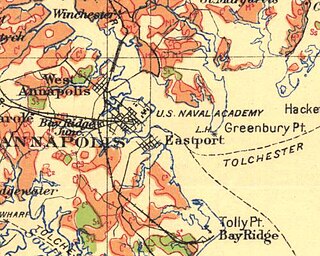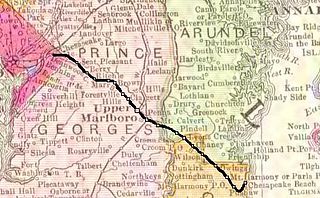
Calvert County is a county located in the U.S. state of Maryland. As of the 2020 census, the population was 92,783. Its county seat is Prince Frederick. The county's name is derived from the family name of the Barons of Baltimore, the proprietors of the English Colony of Maryland. Calvert County is included in the Washington–Arlington–Alexandria, DC–VA–MD–WV Metropolitan Statistical Area. It occupies the Calvert Peninsula, which is bordered on the east by Chesapeake Bay and on the west by the Patuxent River. Calvert County is part of the Southern Maryland region. The county has one of the highest median household incomes in the United States. It is one of the older counties in Maryland, after St. Mary's, Kent County and Anne Arundel counties.

Highland Beach is a town in Anne Arundel County, Maryland, United States. Per the 2020 census, the population was 118. The town was founded late in the 19th century by affluent African Americans from Washington, D.C., and Baltimore, looking for a summer retreat on the Chesapeake Bay. The town's incorporated status gave it a unique standing in empowering it to maintain its own police force. Celebrities with homes there have included historian and author Alex Haley, actor and comedian Bill Cosby, and tennis champion Arthur Ashe. Street names in the town include Crummell, Dunbar, Henson, Augusta, Douglass, Langston, and Washington, which were chosen to honor leading African Americans.

Mayo is a census-designated place (CDP) in Anne Arundel County, Maryland, United States. The population was 8,298 in the 2010 census. The Mayo CDP of 2010 includes all of the area that used to be counted as the Selby-on-the-Bay CDP. The beach in Mayo used to be a popular weekend resort.

Chesapeake Beach is a town in Calvert County, Maryland, United States. Its major attractions include the Chesapeake Beach Railway Station, the Chesapeake Beach Rail Trail, a water park, marinas, piers, and charter boat fishing. The town's population was recorded as 5,753 in the 2010 census.

North Beach is a town in Calvert County, Maryland, United States. The population was 1,978 at the 2010 U.S. Census.

Owings is a town center and census-designated place (CDP) in northern Calvert County, Maryland, United States. The population was 2,149 at the 2010 census, up from 1,325 in 2000.

Prince Frederick is an unincorporated community and census-designated place (CDP) in Calvert County, Maryland, United States. As of the 2020 census, the population of Prince Frederick was 3,226, up from 2,538 in 2010. It is the county seat of Calvert County.

Betterton is a town in Kent County, Maryland, United States. The population was 345 at the 2010 census.

The Monocacy River is a free-flowing left tributary to the Potomac River, which empties into the Atlantic Ocean via the Chesapeake Bay. The river is 58.5 miles (94.1 km) long, with a drainage area of about 970 square miles (2,500 km2). It is the largest Maryland tributary to the Potomac.
The Chitlin' Circuit was a collection of performance venues found throughout the eastern, southern, and upper Midwest areas of the United States. They provided commercial and cultural acceptance for African-American musicians, comedians, and other entertainers following the era of venues run by the "white-owned-and-operated Theatre Owners Booking Association (TOBA)...formed in 1921." The Chitlin Circuit sustained black musicians and dancers during the era of racial segregation in the United States from the 1930s through the '60s.

Buckroe Beach is a neighborhood in the independent city of Hampton, Virginia. It lies just north of Fort Monroe on the Chesapeake Bay. One of the oldest recreational areas in the state, it was long located in Elizabeth City County near the downtown area of the lost town of Phoebus prior to their consolidation with Hampton in 1952.

The Bay Ridge and Annapolis Railroad was a 4.5-mile long short line railroad in central Maryland. It ran 4.5 miles from a junction with the Annapolis, Washington and Baltimore Railroad to the resort town of Bay Ridge, Maryland. It mainly provided transportation between Annapolis and the resort, but also connected with a carferry and steamer service to the Eastern Shore. A small connection was eventually made to the Baltimore and Annapolis Short Line. Shortly after opening it fell under the control of the Baltimore and Ohio Railroad. It was never able to make money so it was shut down in 1904 and the tracks were removed in 1918. Almost no sign of it remains today.
Arundel-on-the-Bay is a former post village and resort area in Anne Arundel County, Maryland, United States, located approximately 2 miles (3.2 km) southeast of Annapolis. Arundel-on-the-Bay is located on a peninsula known as the Annapolis Neck and is a peninsula in and of itself, bordered on the east and south by the Chesapeake Bay, and by Fishing Creek on the west.
Beverley Beach is an unincorporated community in Anne Arundel County, Maryland, United States.

The Chesapeake Beach Railway (CBR), now defunct, was an American railroad of southern Maryland and Washington, D.C., built in the 19th century. The CBR ran 27.629 miles from Washington, D.C., on tracks formerly owned by the Southern Maryland Railroad and then on its own single track through Maryland farm country to a resort at Chesapeake Beach. The construction of the railway was overseen by Otto Mears, a Colorado railroad builder, who planned a shoreline resort with railroad service from Washington and Baltimore. It served Washington and Chesapeake Beach for almost 35 years, but the Great Depression and the rise of the automobile marked the end of the CBR. The last train left the station on April 15, 1935. Parts of the right-of-way are now used for roads and a future rail trail.

Fort Smallwood Park is a county park in northeastern Anne Arundel County, near Riviera Beach and Pasadena, Maryland, United States. It is located on the outer Patapsco River as it meets the Chesapeake Bay, on a peninsula known as Rock Point.
The Baltimore, Chesapeake and Atlantic railroad, nicknamed Black Cinders & Ashes, ran from Claiborne, Maryland, to Ocean City, Maryland. It operated 87 miles (140.0 km) of center-line track and 15.6 miles (25.11 km) of sidings. Chartered in 1886, the railroad started construction in 1889 and cost $2.356 million ($2024=79,895,000).
Sparrow's Beach was a beachfront resort on the Chesapeake Bay that catered to African American patrons during segregation in the American South.

During the decades of segregation in the United States, African Americans established various resorts. The resorts were self-contained commercial establishments. Varying resort accommodations included rooms for rent, meals and fine food, cocktail bars, dancing, sporting facilities, and beaches. Also in some cases entire communities were known as resort areas for African Americans. The Negro Motorist Green Book helped guide African Americans to accommodating and safe places, including Idlewild, Michigan, which was among the most well known.














